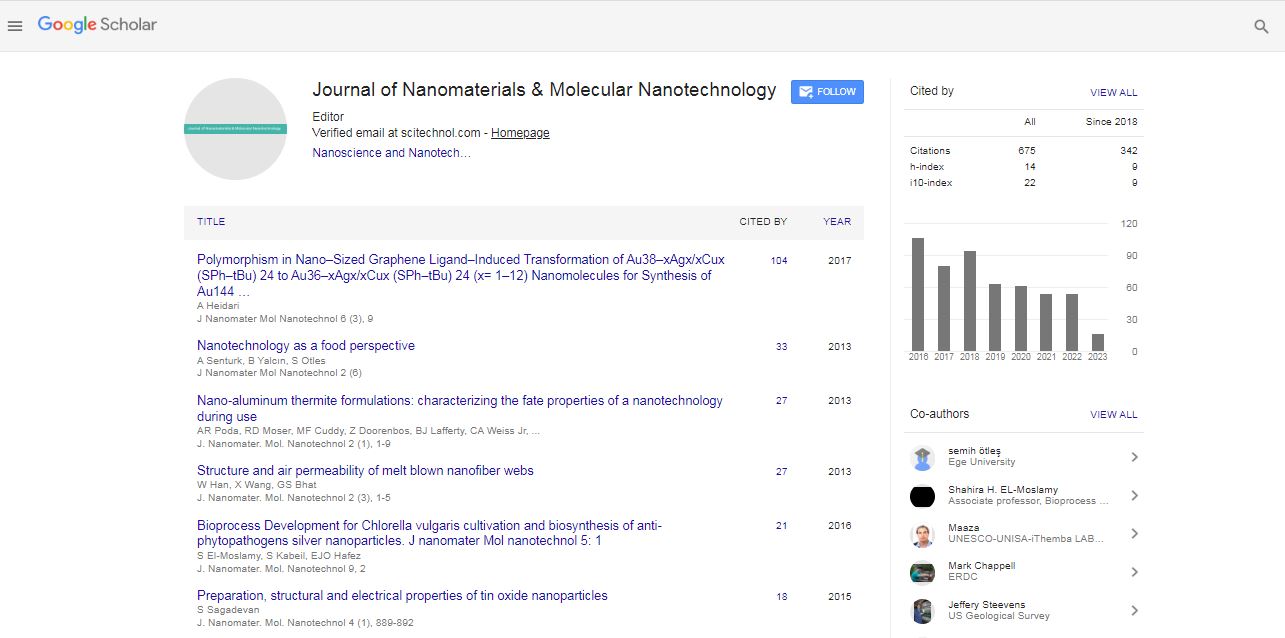Magnetically-actuated nanoparticles: A novel method to unravel the molecular mechanisms evoked by mechanical tension
Alessandro Falconieri, Sara De Vincentiis, Domenica Convertino, Sofia Figoli, Samuele Ghignoli, Valentina Cappello, Laura Marchetti,
Ugo Borello and Vittoria Raffa
Università di Pisa, Italy
CNI@NEST, Italy
Center for Materials Interfaces, Italy
: J Nanomater Mol Nanotechnol
Abstract
Magnetic nanoparticles (MNPs) are emerging as a novel technology in biomedicine and nanomedicine. The use of MNPs, as well as that of magnetic fields, is already an accepted practice for therapeutic purposes on humans. The actuation of the MNPs allows to generate very low forces, similar to those generated endogenously by the cell. Here, we propose a methodology to study the effect of extremely low forces, exogenously applied, on mice hippocampal neurons. In the recent past, our team developed a method to apply forces on neurons by labeling the neurites with MNPs and by generating an external magnetic field (1, 2). We found an increase in axonal length, without reduction of the caliber, an accumulation of microtubules and endoplasmic reticulum cisternae and a reduction of intracellular calcium level, consistent with a situation in which a fast axonal elongation rate was found (3). Interestingly, recently our group also found similar hallmarks by stimulating neurons with a different technology (4). It suggests that pathways activated by force could be evoked independently of the methodology used. To study the molecular mechanisms activated by tension at both the somatic and axonal levels, we developed a method that allowed us to isolate the two compartments. Interestingly, looking into the axonal component, we found alterations in local phenomena, i.e. axonal transport and local translation. Considering that some of the protagonists of local translation are transported along the axon, we speculate that our forces magnetically-actuated contribute to create a dialogue between the two local phenomena. In light of our observations we hypothesize that microtubules, previously identified as a possible tension sensor (5), could be responsible for the creation of this “cross-talk”.
Recent Publications:
1. Raffa, V., F. Falcone, S. De Vincentiis, A. Falconieri, M.P. Calatayud, G.F. Goya, and A. Cuschieri. 2018. Piconewton mechanical forces promote neurite growth. Biophys. J. 115:2026–2033.
2. De Vincentiis, S., A. Falconieri, M. Mainardi, V. Cappello, V. Scribano, R. Bizzarri, B. Storti, L. Dente, M. Costa, and V. Raffa. 2020. Extremely low forces induce extreme axon growth. J. Neurosci. 40:4997– 5007.
3. Rosenberg, S.S., and N.C. Spitzer. 2011. Calcium signaling in neuronal development. Cold Spring Harb. Perspect. Biol. 3:a004259.
4. Falconieri, A., N. Taparia, S. De Vincentiis, V. Cappello, N.J. Sniadecki, and V. Raffa. 2021. MAGNETICALLY-ACTUATED MICROPOSTS STIMULATE AXON GROWTH. Biophys. J.
5. Hamant, O., D. Inoue, D. Bouchez, J. Dumais, and E. Mjolsness. 2019. Are microtubules tension sensors? Nat. Commun. 10:2360.
Biography
Alessandro Falconieri has his expertise in the field of molecular biology, nanotechnologies and neuro-mechanobiology. His study of axonal growth following mechanical stimulation proposes a new model of neuritic development based on the establishment of a complex dialogue between local phenomena (i.e. axonal transport and local translation). The model based on this "cross-talk" came from his PhD work which ended in June 2021. In the recent period, he is investigating the molecular pathways activated by tension (with particular focus on signal transduction) as well as the mechanisms of repair and recovery following prolonged stimulation. The prospect of exploiting mechanical stimulation to accelerate the rate of axonal outgrowth is very intriguing as it would give the possibility of proposing a new therapeutic target for the treatment of neurons damaged following injury or disease.




